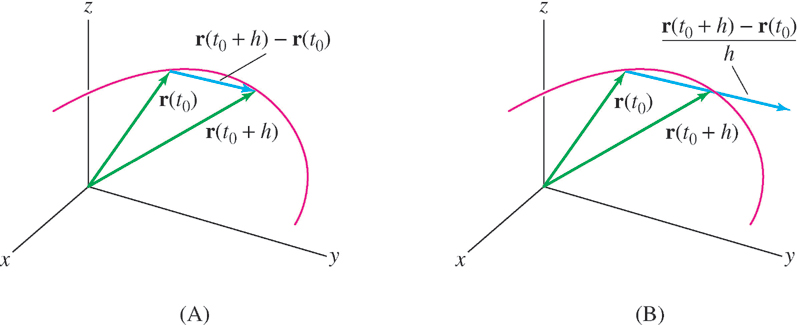The Derivative as a Tangent Vector
The derivative vector r′(t0) has an important geometric property: It points in the direction tangent to the path traced by r(t) at t = t0.
To understand why, consider the difference quotient, where Δr = r(t0 + h) − r(t0) and Δt = h with h ≠ 0:

Although it has been our convention to regard all vectors as based at the origin, the tangent vector r′(t) is an exception; we visualize it as a vector based at the terminal point of r(t). This makes sense because r′(t) then appears as a vector tangent to the curve (Figure 3).
The vector Δr points from the head of r(t0) to the head of r(t0 + h) as in Figure 2(A). The difference quotient Δr/Δt is a scalar multiple of Δr and therefore points in the same direction [Figure 2(B)].

As h = Δt tends to zero, Δr also tends to zero but the quotient Δr/Δt approaches a vector r′(t0), which, if nonzero, points in the direction tangent to the curve. Figure 3 illustrates the limiting process. We refer to r′(t0) as the tangent vector or the velocity vector at r(t0).

The tangent vector r′(t0) (if it is nonzero) is a direction vector for the tangent line to the curve. Therefore, the tangent line has vector parametrization:

735
EXAMPLE 5: Plotting Tangent Vectors
 Plot r(t) = 〈cos t, sin t, 4 cos2 t〉 together with its tangent vectors at
Plot r(t) = 〈cos t, sin t, 4 cos2 t〉 together with its tangent vectors at  and
and  . Find a parametrization of the tangent line at
. Find a parametrization of the tangent line at  .
.
Solution The derivative is r′(t) = 〈− sin t, cos t, −8 cos t sin t〉, and thus the tangent vectors at  and
and  are
are

Figure 4 shows a plot of r(t) with  based at
based at  and
and  based at
based at  .
.

r(t) = 〈cos t, sin t, 4 cos2 t〉 at
 .
.At  and thus the tangent line is parametrized by
and thus the tangent line is parametrized by

There are some important differences between vector-
EXAMPLE 6: Horizontal Tangent Vectors on the Cycloid
The function
r(t) = 〈t − sin t, 1 − cos t〉
traces a cycloid. Find the points where:
r′(t) is horizontal and nonzero.
r′(t) is the zero vector.
736
Solution The tangent vector is r′(t) = 〈1 − cos t, sin t〉. The y-component of r′(t) is zero if sin t = 0—

By periodicity, we conclude that r′(t) is nonzero and horizontal for t = π, 3π, 5π,…and r′(t) = 0 for t = 0, 2π, 4π,…(Figure 5).

CONCEPTUAL INSIGHT
The cycloid in Figure 5 has sharp points called cusps at points where x = 0, 2π, 4π,…. If we represent the cycloid as the graph of a function y = f(x), then f′(x) does not exist at these points. By contrast, the vector derivative r′(t) = 〈1 − cos t, sin t〉 exists for all t, but r′(t) = 0 at the cusps. In general, r′(t) is a direction vector for the tangent line whenever it exists, but we get no information about the tangent line (which may or may not exist) at points where r′(t) = 0.
The next example establishes an important property of vector-
EXAMPLE 7: Orthogonality of r and r′ When r Has Constant Length
Prove that if r(t) has constant length, then r(t) is orthogonal to r′(t).
Solution By the Product Rule for Dot Products,

This derivative is zero because ∥r(t)∥ is constant. Therefore r(t) · r′(t) = 0, and r(t) is orthogonal to r′(t) [or r′(t) = 0].
GRAPHICAL INSIGHT
The result of Example 7 has a geometric explanation. A vector parametrization r(t) consisting of vectors of constant length R traces a curve on the surface of a sphere of radius R with center at the origin (Figure 6). Thus r′(t) is tangent to this sphere. But any line that is tangent to a sphere at a point P is orthogonal to the radial vector through P, and thus r(t) is orthogonal to r′(t).
